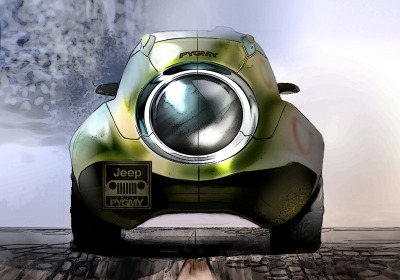College Exhibition: IED Fiat/Chrysler project
Fri, 13 Nov 2009Second year students at the Istituto Europeo di Design (IED) in Turin, Italy, recently completed a Fiat/Chrysler sponsored project, which began in February 2009. Conceived as a didactic exercise to think about the recent alliance between Fiat and Chrysler, 37 students were asked to design a vehicle capable of combining the technical know-how, platforms and values of both brands in order to generate interesting and competitive new products for the European and the American markets.
In creating their concepts, students were asked to take into account the style, economic accessibility and the low environmental impact of Fiat vehicles as well as the new platforms and major industrial and production capacity afforded by the Italian automaker's alliance with the Chrysler brand. A brief was presented that required the students to devise their own visions of the future and deduce how relations between the two brands might develop before the two brands reached a final and historical agreement.
"Which and what will the vehicles of tomorrow be like? The union of the Fiat and Chrysler brands brings with it the potential to find an adequate answer to this question," said César Mendoza, Director of IED Turin. "To get students to work on such an up-to-date issue, even before the official announcement of the agreement, has proven to be a real challenge for our [school]."
The workshop was coordinated by a team of teachers who were able to help the students work on both the interior and the exterior and oversaw the development of the projects using Alias. During the project, students met with designers at the Fiat Style Centre, which turned out to be fundamental in giving the project substance.
The students worked individually and, among the proposals presented, the team that oversaw the project selected 13, including the projects created by Pira Invernizzi and Nava Montesanti. The projects by Vasily Kurkov and Roberto Testolin were then chosen to be produced as 1:4 scale models.
Biov concept
Roberto Testolin
Targeting a youthful consumer unaware of environmental issues, this proposal aims to reduce the production costs of an ecological vehicle positioned in the A segment. The vehicle has very few surfaces and they are made from plastic material that is easy to produce and very light. These components, assembled by means of a system of layering, reduce the vehicle's production complexity and engineering costs.
Pygmy Jeep concept
Vasiliy Kurkov
Unlike the Biov, this concept vehicle is based on the Fiat Panda Cross 4x4 platform. Though it exudes European character, it is also infused by American Culture and the quintessential Jeep spirit. A two-seat vehicle that offers a variety of stylistic options, the Pygmy is a universal car that can be made to transform from a shopping car to an off-road vehicle, depending on the user's needs. The interior brings together fashion and retro elements with other high-tech details, transmitting a sense of luxury and quality.
Fiat Crossover Blu
Pira Invernizzi
This sport crossover concept is based on the Dodge Caliber platform. The idea was to create a versatile car for all purposes, which allowed for lighthearted daily usage. The body, completely realized with flexible materials instead of sheet metal, focuses on lightness. These flexible panels can be easily attached with magnetic clips and the softened exterior shell is also less susceptible to damage, neatly sidestepping the cost and time for manufacturing and repair.
Fiat New Campagnola
Nava Montesanti
Designed for off-road use, this vehicle features an exterior skin made of multiple layers of leather. Where the material is required to bend, and to avoid employing hinges, the layers are thinner. This varying thickness enables the linear bending of the skin where necessary. A tent, stowed in the stowage space between the rear edge of the roof and side panels, can be opened in seconds if necessary to provide shelter and privacy. Inside the cabin, the door panels are made of material that can be bent, serving as protection for the occupants or an armrest.
By Eric Gallina

